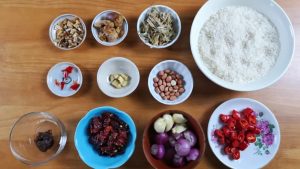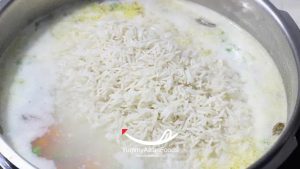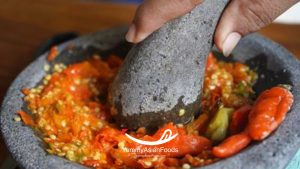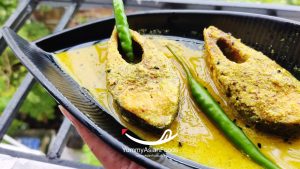Table of Contents
ToggleMalaysian cuisine has gained widespread popularity for its unique blend of flavors and diverse influences, making it a favorite among food enthusiasts worldwide. At the heart of this culinary acclaim is the beloved national dish and popular street food in Malaysia, Nasi Lemak. This iconic Malaysian nasi lemak, which translates to “fatty rice,” is a fragrant coconut rice dish served with a variety of accompaniments such as crispy anchovies, roasted peanuts, hard-boiled eggs, cucumber slices, and spicy sambal. Its versatility and delicious combination of savory, sweet, and spicy flavors have made it a staple in Malaysian culture and a must-try for visitors. Despite its delectable reputation, cooking Malaysian nasi lemak at home is surprisingly easy and simple, allowing enthusiasts to savor its authentic taste in their own kitchens.
How to Cook Malaysian Nasi Lemak
Malaysian Nasi Lemak is a popular dish that features fragrant rice cooked in coconut milk and served with a variety of accompaniments. To make this flavorful dish, start by rinsing the rice and then cooking it with coconut milk, pandan leaves, and a pinch of salt. While the rice is cooking, prepare the sambal, which is a spicy chili paste, and fry some anchovies and peanuts for added crunch. Once everything is ready, serve the Malaysian nasi lemak with a hard-boiled egg and fresh cucumber slices for a delicious and satisfying meal.
1. Gathering Ingredients
To make the authentic Malaysian nasi lemak, you will need a few key ingredients, such as fragrant rice, coconut milk, pandan leaves, and anchovies. These ingredients form the foundation of the dish and contribute to its distinct flavor profile. The fragrant rice, when cooked with coconut milk and pandan leaves, gives the nasi lemak its signature aroma and rich, creamy texture. Additionally, the crispy anchovies add a delightful crunch and savory flavor to the dish, enhancing its overall taste.
Sourcing fresh and authentic ingredients is crucial when preparing nasi lemak as it greatly impacts the final flavor and quality of the dish. Using high-quality, fresh ingredients ensures that the dish stays true to its traditional roots and captures the essence of Malaysian cuisine. For example, fresh coconut milk imparts a creamy richness that is essential to Malaysian nasi lemak, while authentic pandan leaves infuse a unique aromatic flavor that sets this dish apart. By sourcing these ingredients, you can achieve the authentic nasi lemak flavor that is beloved by many.

List of Ingredients for Malaysian Nasi Lemak
Rice:
- 2 cups coconut milk
- 2 cups water
- 2 cups long grain rice, rinsed and drained
- 1 (1/2 inch) piece fresh ginger, peeled and thinly sliced
- ¼ teaspoon ground ginger
- 1 whole bay leaf
- salt to taste
Garnish:
- 1 cup oil for frying
- 1 cup raw peanuts
- 1 (4 ounce) package white anchovies, washed
- 4 large hard-boiled eggs, peeled and halved
- 1 medium cucumber, sliced
The Sauce:
- 2 tablespoons vegetable oil
- 1 medium onion, sliced
- 3 medium shallots, thinly sliced
- 3 cloves garlic, thinly sliced
- 2 teaspoons chile paste
- 1 tablespoon water, or more as needed (Optional)
- 1 (4 ounce) package white anchovies, washed
- ¼ cup tamarind juice
- 3 tablespoons white sugar
- salt to taste
2. Cooking the Rice and Coconut Milk
Cooking the rice for Malaysian nasi lemak is a simple yet crucial step in achieving the perfect texture and flavor. Start by rinsing the rice thoroughly to remove excess starch. Then, in a pot, combine the rinsed rice with coconut milk and a few pandan leaves for added fragrance. Bring the mixture to a gentle boil, then reduce the heat to low and let it simmer, covered until the rice is fluffy and has absorbed all the coconut milk. This step is essential in creating the creamy and aromatic base for the nasi lemak, as the coconut milk infuses the rice with its rich flavor and gives it a luscious texture.
The key to achieving the right texture and flavor in Malaysian nasi lemak lies in the cooking process of the rice with coconut milk and pandan leaves. This simple yet crucial step involves simmering the rice in coconut milk, and pandan leaves until it reaches a fluffy and creamy consistency. The coconut milk infuses the rice with its rich and luscious flavor, while the pandan leaves add a delightful fragrance. This process is essential in creating the base for the iconic nasi lemak, as the rice forms the foundation of this beloved dish, providing a satisfying and aromatic complement to the flavorful accompaniments.

3. Preparing the Condiments and Sambal
When preparing the condiments for Malaysian nasi lemak, start by frying the anchovies until they turn golden and crispy, then set them aside. Next, roast the peanuts in a dry pan until they are fragrant and slightly browned. Finally, hard-boil the eggs until they are cooked through, and then peel and slice them. These condiments are essential for adding texture and flavor to the beloved Malaysian nasi lemak.
To make the spicy sambal sauce for nasi lemak, begin by blending together dried chilies, shallots, garlic, belacan (shrimp paste), and a touch of sugar in a food processor until it forms a smooth paste. Then, heat oil in a pan and fry the paste until it turns fragrant and the oil separates. Add in tamarind juice and salt, then simmer the mixture until it thickens into a rich and spicy sambal sauce. This flavorsome sambal sauce is a crucial component of nasi lemak, adding a fiery kick to the fragrant coconut rice and complementing the savory condiments.

4. Assembling and Serving
When assembling Malaysian nasi lemak, start by arranging a serving of fragrant coconut rice in the center of a banana leaf or plate. Next, place small portions of traditional condiments such as crispy anchovies, roasted peanuts, sliced cucumbers, and hard-boiled eggs around the rice. The star of the dish, the sambal, should be placed in a separate section to allow diners to control the spiciness level. To enhance the visual appeal and flavor of the nasi lemak, consider adding a sprinkle of fried shallots and a wedge of lime as additional garnishes.
For serving Malaysian nasi lemak, it is recommended to pair the dish with a side of crispy fried chicken or fish for a complete meal. Additionally, a dollop of creamy coconut milk-based sambal and a fresh sprig of fragrant pandan leaves can be added to elevate the dish’s taste and presentation. To complete the experience, serve the nasi lemak with a refreshing iced beverage such as sweetened pandan or barley water. The combination of flavors and textures in nasi lemak makes it a versatile dish that can be enjoyed for breakfast, lunch, or dinner.

The Difference Between Filipino Breakfast Tapsilog and Malaysian Nasi Lemak
One key difference between Filipino breakfast tapsilog and Malaysian Nasi Lemak lies in their respective main components. Tapsilog consists of tapa (marinated beef), sinangag (garlic fried rice), and itlog (fried egg), creating a hearty and savory meal. On the other hand, Nasi Lemak features fragrant coconut rice served with anchovies, peanuts, cucumber slices, boiled eggs, and a flavorful sambal sauce that adds a spicy kick to the dish.
Another distinction is the flavor profile of these breakfast dishes. Tapsilog offers bold flavors from the tender marinated beef combined with garlicky rice and rich fried egg. In contrast, Nasi Lemak is known for its complex combination of sweet, salty, spicy, and tangy elements that create a unique umami experience for the taste buds. Both dishes showcase the diverse culinary influences present in Filipino and Malaysian cuisine while offering distinct dining experiences worth exploring.
Summing Up: How to Cook Malaysian Nasi Lemak
In conclusion, preparing Malaysian nasi lemak at home is a simple and speedy process that allows anyone to experience the authentic taste of Malaysian street food and the country’s beloved national dish. This flavorful and aromatic dish embodies the vibrant street food culture of Malaysia and is a testament to the nation’s rich culinary traditions. By trying your hand at cooking Nasi Lemak, you can savor the true essence of Malaysian cuisine and immerse yourself in the tantalizing flavors of this beloved street food. So, why not embark on a culinary adventure and bring the vibrant spirit of Malaysian street food into your own kitchen?















